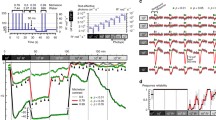Abstract
Cone electroretinograms are typically isolated by presenting stimulus flashes against rod-desensitizing adapting fields. To investigate the manner in which adapting-field luminance affects cone electroretinogram response properties, we measured cone electroretinogram luminance-response functions of two normal subjects, with stimuli presented against adapting fields that ranged in luminance from -1.2 to 2.1 log cd/m2. A flicker rate of 31.1 Hz was used to isolate cone electroretinograms under all adaptation conditions. A hyperbolic equation of the form (R/Rmax)=Ln/(Ln+Kn) was fitted to each luminance-response function by a least-squares criterion. As adapting field luminance increased, the best-fit values of the variables K and n increased, which is in general agreement with results of electrophysiologic studies of light adaptation in retinal neurons. However, Rmax values also increased with adapting field luminance. The change in all three of these variables with adapting field luminance must be considered in the interpretation of cone electroretinogram luminance-response functions from patients with retinal disorders.
Similar content being viewed by others
References
Arden GB, Carter RM, Hogg CR, Powell DJ, Ernst WJK, Clover GM, Lyness AL, Quinlan MP. A modified ERG technique and the results obtained in X-linked retinitis pigmentosa. Br J Ophthalmol 1983; 67: 419–30.
Massof RW, Wu L, Finkelstein D, Perry C, Starr SJ, Johnson MA. Properties of electroretinographic intensity-response functions in retinitis pigmentosa. Doc Ophthalmol 1984; 57: 279–96.
Hood DC. Testing hypotheses about development with electroretinographic and incremental-threshold data. J Opt Soc Am A 1988; 5: 2159–65.
Yagasaki K, Jacobson SG, Apathy PP, Knighton RW. Rod and cone psychophysics and electroretinography: Methods for comparison in retinal degenerations. Doc Ophthalmol 1988; 69: 119–30.
Peachey NS, Alexander KR, Fishman GA, Derlacki DJ. Properties of the human cone system electroretinogram during light adaptation. Appl Optics 1989; 28: 1145–50.
Marchese A, Brigell M. Amplitude-intensity function of the photopic ERG and VEP [Abstract]. Invest Ophthalmol Vis Sci 1990; 31(suppl): 606.
Peachey NS, Alexander KR, Derlacki DJ, Fishman GA. Light adaptation, rods, and the human cone flicker ERG. Vis Neurosci. 1992; 8: 145–50.
Normann RA, Werblin FS. Control of retinal sensitivity, I: Light and dark adaptation of vertebrate rods and cones. J Gen Physiol 1974; 63: 37–61.
Normann RA, Perlman I. The effects of background illumination on the photoresponses of red and green cones. J Physiol 1979; 286: 491–507.
Normann RA, Perlman I. Signal transmission from red cones to horizontal cells in the turtle retina. J Physiol 1979; 286: 509–24.
Malchow R, Yazulla S. Separation and light adaptation of rod and cone signals in the retina of the goldfish. Vision Res 1986; 26: 1655–66.
Malchow RP, Yazulla S. Light adaptation of rod and cone luminosity horizontal cells of the retina of the goldfish. Brain Res 1988; 443: 222–30.
Sieving PA, Murayama K, Naarendorp F. Monkey cone ERG b-wave results from interaction of depolarizing and hyperpolarizing pathways [Abstract]. Invest Ophthalmol Vis Sci 1991; 32(suppl): 927.
Yang X-L, Tornqvist K, Dowling JE. Modulation of cone horizontal cell activity in the teleost fish retina, I: Effects of prolonged darkness and background illumination on light responsiveness. J Neurosci 1988; 8: 2259–68.
Yang X-L, Tornqvist K, Dowling JE. Modulation of cone horizontal cell activity in the teleost fish retina, II: Role of interplexiform cells and dopamine in regulating light responsiveness. J Neurosci 1988; 8: 2269–78.
Peachey NS, Alexander KR, Fishman GA. Visual adaptation and the cone flicker electroretinogram. Invest Ophthalmol Vis Sci 1991; 32: 1517–22.
Peachey NS, Fishman GA, Kilbride PE, Alexander KR, Keehan KM, Derlacki DJ. A form of congenital stationary night blindness with apparent defect of rod phototransduction. Invest Ophthalmol Vis Sci 1990; 31: 237–46.
Author information
Authors and Affiliations
Rights and permissions
About this article
Cite this article
Peachey, N.S., Alexander, K.R., Derlacki, D.J. et al. Light adaptation and the luminance-response function of the cone electroretinogram. Doc Ophthalmol 79, 363–369 (1992). https://doi.org/10.1007/BF00160949
Accepted:
Issue Date:
DOI: https://doi.org/10.1007/BF00160949




